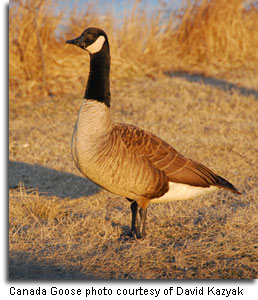Canada Goose
(Branta canadensis)
 Description & Range:
Description & Range:
Canada Geese are common in Maryland, and we have populations of both migratory and resident Canada Geese. The migratory Canada Geese overwinter in Maryland but are part of the Atlantic population that nestsin northern Québec along Ungava Bay, the northeastern shore of Hudson Bay (where 80% of the breeding birds are found!), and in the interior of the Ungava Peninsula. In contrast, the resident Canada Geese are distinct from their migratory cousins. These year-round residents may be products of our state’s earliest Canada Goose stocking in Maryland, which dates back to 1935 when a group of 41 geese were transplanted from the Midwest to Dorchester County.
Both sexes of Canada Geese have a black head and neck except for broad white cheek patches extending from the throat to the rear of the eye. The female of a breeding pair is often smaller. The breast, abdomen and flanks range in color from a light gray to a dark chocolate brown, either blending into the black neck or being separated from it by a white collar. The back and scapulars are darker brown, the rump is blackish and the tail is blackish-brown with a U-shaped white band on the rump. The bill, legs and feet are black.
Habitat:
Canada Geese inhabit ponds, lakes, marshes and fields, as well as city parks and golf courses. They tend to like low areas with lots of open water, which provides them with safety from predators. For nesting, Canada Geese like upland areas near water. Quite often, they will nest on an island.
Diet:
Canada Geese are grazers, often dipping their heads below the water’s surface to feed on bay grasses. They have also become accustomed to eating agricultural “leftovers” in fields of corn, soybean, and wheat. Canada Geese can also be found grazing on lawns, in parks and on golf courses. In the spring and summer months, the geese eat leaves, flowers, stems, roots, seeds and berries. They will often eat for 12 hours or more a day to consume a sufficient amount of nutrients. They feed even more intensively right before they fly north after the winter, storing energy for an active breeding period and preparing for a lack of food in the spring.
 Reproduction:
Reproduction:
Canada Geese exhibit very strong family and pair bonds, and tend to return to nest in the same area where they were reared. Females first breed when they are 2-4 years old. Canada Geese mate for life and can live up to 25 years. However, if one mate dies, the other will re-mate.
In Maryland, breeding of resident Canada Geese takes place early in the year, with nesting usually happening from late March to early May. Females typically lay about 5 eggs and incubate them for about 28 days. During the nesting and incubation period, the male stays near the nest and keeps a close eye on the female and the eggs. If a predator should threaten them, the male will attempt to protect the nest by luring the predator away. Both parents care for the young; family groups stay together for several months.
Sounds:
While many people only hear the trademark “honk” when geese make noise, there is evidence that Canada Geese can communicate with different sounds. Scientists believe that there are as many as 13 different Canada Goose calls for things like greetings, warnings and contentment.
Behavior:
As a social species, Canada Geese tend to gather in large flocks. During migration they can sustain flight speeds of over 35 miles an hour. To do so, they fly in the distinct “V” pattern, where one goose is the leader and its flock follows behind in a v-shape. This helps the geese keep in visual contact and possibly save energy when they migrate by benefitting from the air currents passing the leader.
Canada Geese are managed as Waterfowl in Maryland.
To learn more about
Canada Goose management, then please click here.